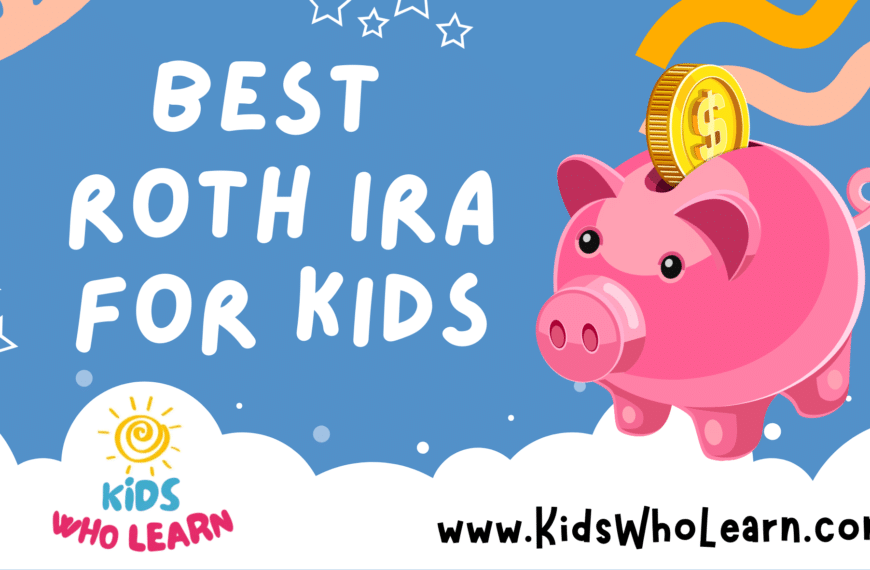Choosing the best bank for a child’s first account is a significant decision that can teach them critical financial skills and the value of saving money. Many banks have crafted accounts and services that cater specifically to the younger demographic. These accounts typically come with features tailored to help children and teens grasp the fundamentals of personal finance, offering tools for saving and spending responsibly. Securing the right financial institution for your child not only helps in setting up a solid foundation for their financial future but also instills in them crucial money management skills from an early age.
However, with the plethora of banking options available, it is imperative to assess which bank aligns best with your child’s needs. A good bank for kids will offer a combination of educational resources, easy account management, and opportunities for growing their savings. This involves considering factors such as the ease of depositing money, the availability of educational resources, the presence of any account fees, and how the account can evolve as the child grows. Parents should also contemplate the security measures the bank employs to safeguard their child’s funds and personal information.
Key Takeaways
- A child’s bank account is a practical tool for teaching money management and saving from an early age.
- When selecting a bank, assess features like educational resources, account management, fees, and growth potential.
- Ensure the bank prioritizes security and adheres to regulations, providing a safe environment for your child’s financial journey.
Understanding Child-Focused Banking
Child-focused banking is tailored to meet the unique financial needs of minors, providing the foundational tools for personal finance from an early age.
What Is a Kids Savings Account?
A kids savings account is a type of deposit account at a bank or credit union specifically designed for children and teens. This account allows you to deposit funds that earn interest over time, serving as an effective tool for teaching the basics of saving and banking.
Key Details:
- Age Range: Typically available for individuals under 18 years of age.
- Ownership: These accounts are generally joint accounts with a parent or guardian.
- Interest Rates: Often have competitive interest rates to encourage savings.
- Fees: Minimal or no monthly fees, making them cost-effective for young savers.
Benefits of Banking for Kids
Introducing your child to banking has numerous benefits that can positively affect their future financial well-being.
- Financial Literacy: Acquainting children with banking concepts early on fosters financial literacy, equipping them with skills for managing money.
- Responsibility: Having an account encourages responsibility and accountability as they monitor their savings and transactions.
- Saving Habits: It encourages the development of regular saving habits, which can lead to a lifetime of smart financial choices.
These benefits provide a practical foundation for children as they grow into financially savvy adults. Bank and credit union programs may also include educational materials that further empower your child’s understanding of personal finance within a safe and regulated financial institution setting.
Evaluating Bank Offerings
When looking for the best bank for your child, it’s essential to consider the features specific to kids’ accounts, the types of accounts available, and the financial benefits provided. Examining these factors will help you find the most suitable and beneficial banking experience for your child.
Important Features in Kids’ Bank Accounts
Your primary focus should be on accounts designed with minors in mind. Savings accounts for kids usually offer tools for financial education, such as interactive banking apps. These accounts often have no or low fees to keep costs minimal. Look for banks that provide an interest rate or APY (Annual Percentage Yield) geared towards incentivizing savings. Additionally, parental control features are crucial for monitoring and guiding your child’s spending and saving habits.
Comparison of Account Types
There are mainly two types of accounts to consider:
- Savings account for kids: Typically, these accounts have lower fees and offer an educational component. They are designed to teach savings habits.
- Checking accounts: Suitable for older children ready to learn about making transactions. Some checking accounts for youth might earn interest, but the focus is more on functionality than savings growth.
| Account Type | Primary Benefit | Fees | Interest Earnings |
|---|---|---|---|
| Savings account for kids | Financial Education | Low or None | Yes |
| Teen checking account | Transaction Learning | Varying; often low | Less common |
Assessing Savings and Checking Accounts
When evaluating savings and checking accounts, it’s necessary to look at the APY and interest rates. High-yield savings accounts generally offer a more competitive APY, leading to better growth of savings over time. For checking accounts, although interest is less common, it’s crucial to ensure the availability of essential features such as debit cards and online banking, ideally without steep fees. Always compare these aspects:
- APY: Higher APY helps savings grow faster.
- Interest rate: Even a small difference can result in significant savings growth.
- Fees: Look for accounts with minimal fees to protect your child’s earnings.
Remember, the best account will have a balance of these features tailored to your child’s banking needs.
Financial Education and Tools
In today’s digital age, it’s crucial for you to empower your children with a strong foundation in handling finances. Effective tools and education can set them up for a lifetime of financial responsibility and success.
Teaching Financial Literacy to Children
Teaching your kids about financial literacy means going beyond the piggy bank. It’s essential to introduce real-world financial concepts early on. Many banks offer kid’s savings accounts that can be an excellent start to understanding how to manage money. For instructional purposes, look for accounts that come with educational resources tailored to young learners. These resources can provide insights into savings goals, the importance of an allowance, and how to spend wisely.
Some banks integrate interactive games within their mobile banking apps to make learning about money management fun and engaging. These games often simulate real-life financial scenarios, teaching children to navigate finances in a safe environment. Additionally, certain digital platforms offer progress tracking, giving your children visual representation of their financial goals and achievements.
The Role of Debit Cards and Apps
A debit card designed for kids serves as a practical tool in teaching money management. It allows for real-time experience in spending and oversight from parents. Look for a debit card that comes with a mobile app that facilitates setting spending limits and real-time notifications for transactions. This transparency helps you keep track of your child’s spending habits.
Mobile banking technology also paves the way for children to learn about digital finances. With a user-friendly mobile banking app, kids can easily check their balance, set up savings goals, and understand the value of money. Some apps are designed to help children with budgeting, saving for specific goals, and even introducing basic concepts of investing. Through these tools, your child can start managing their allowance digitally, giving them a modern approach to finances that aligns with today’s banking practices.
Selecting the Right Institution
When choosing the best bank for your child, consider the type of institution, the costs involved, and the specific membership requirements.
Traditional Banks vs Online Banks vs Credit Unions
Traditional banks offer a wide range of services and usually have numerous branches and ATMs which provide convenient access to funds and in-person assistance. Online banks are known for lower or no fees due to their lack of physical branches, often resulting in higher interest rates on accounts. Credit unions, such as Alliant Credit Union, are member-owned and may offer more competitive rates and personalized services, but might have more limited accessibility and online options compared to larger traditional banks.
Evaluating Fees and Accessibility
- Low or No Fees: It’s essential to look at the fee structure.
- Traditional banks may charge for account maintenance, but some offer youth accounts with no fees.
- Online banks can afford to cut many typical banking fees, making them an attractive low-cost option.
- Convenient Access: Consider how your child will access their money.
- Traditional and online banks provide online options and mobile apps for banking on the go.
- Credit unions often participate in shared ATM networks, increasing their accessibility.
Understanding Membership Requirements
Credit unions, such as Alliant Credit Union, have membership requirements based on specific criteria like location, employment, or affiliation with certain groups. Traditional banks and online banks are generally open to all, but it’s crucial to understand the terms of opening and maintaining an account for your child. Checking the eligibility and onboarding process will ensure you select an institution that aligns with your child’s banking needs.
Account Management and Operations
Choosing the best bank for your child involves thorough consideration of how accounts are managed and operated. Ease of account setup, utilizing ATMs and cards, and setting up finances such as direct deposits are essential components.
Opening a Kids Savings Account
When you open a savings account for your child, you typically start with an initial deposit. Some banks have no minimum requirement, while others may require a small amount. Ensure that the account options include automatic savings features, which allow you to set up regular transfers from a linked account to your child’s savings, supporting the development of their financial habits.
Using ATMs and Cards
Banks offer ATM cards for kids’ savings accounts with certain restrictions to ensure security and control. It’s essential to choose a bank that provides free ATM access to a wide network, minimizing the fees that could eat into your child’s savings. Teach your child how to safely use an ATM, check their balance, and understand the importance of secure PIN management.
Setting Up Direct Deposits
Implementing direct deposit for your child’s account can be a convenient way to manage money from allowances or part-time jobs. By directly depositing funds into the savings account, it encourages the discipline of saving and planning for the future. Some banks offer features like bonus interest rates when direct deposits are set up, leveraging your child’s savings potential.
Maximizing Savings Potential
When selecting the best bank for your child, prioritize those that offer high interest rates to maximize the potential growth of their savings.
Finding High-Interest Savings Accounts
Search for savings accounts that provide a high Annual Percentage Yield (APY) to ensure your child’s savings balance benefits from competitive interest rates. Financial institutions often offer high-interest accounts specifically designed for young savers. Here are some steps to find these accounts:
- Compare APYs: Review different banks to find the best high APY offerings.
- Check Requirements: Some accounts offer higher rates with specific conditions, such as minimum balance requirements or regular monthly deposits.
- Examine Compounding: The frequency of interest compounding can affect earnings, with daily or monthly compound interest generally offering the best growth potential.
Using Tools for Saving and Budgeting
Utilize the bank’s savings and budgeting tools to help manage and grow the savings balance effectively.
- Automatic Transfers: Set up automated transfers into the savings account to consistently build the balance.
- Savings Rewards: Look for banks that reward your child for saving with additional interest or bonuses.
- Track and Set Goals: Use budgeting tools provided by the bank to set savings goals and track progress toward these goals.
By focusing on accounts with high APY and engaging with tools that encourage consistent savings and budgeting, you can secure a strong financial foundation for your child’s future.
Considering Additional Benefits
When selecting the best bank for your child’s account, it’s worth examining additional perks beyond the basic savings rates. Tax benefits and bank-offered features can greatly enhance the value of your child’s account.
Exploring Tax Benefits for Child Accounts
Your child’s savings account is subject to tax regulations. The interest earned is considered unearned income and may benefit from the Kiddie Tax rules, which can offer tax advantages. Regarding taxes:
- Under a certain amount: Typically, the first $1,100 of unearned income can be tax-free.
- Next threshold: The next $1,100 is taxed at your child’s tax rate, which is usually lower than adult rates.
It is essential to consult with a tax professional to understand how these benefits apply to your situation.
Special Features and Bonuses
Many banks provide unique features to child accounts to encourage savings habits.
| Feature | Description |
|---|---|
| Automated Savings Plans | Set up automatic transfers to help your child save consistently. |
| Birthday Bonus | Some banks offer a bonus deposit on your child’s birthday. |
| Financial Education Tools | Interactive games and apps to educate your child about financial basics. |
Look for an account that offers a combination of these features to maximize the benefits for your child’s financial future.
Security and Regulation
When selecting a bank for your child, ensuring the safety of their funds is crucial. Opt for banks that are federally insured by the FDIC or credit unions insured by the NCUA to protect your child’s financial future.
Ensuring Safety with FDIC-Insured Accounts
Banks offering FDIC-insured accounts guarantee that your child’s money is safe up to $250,000 per depositor, per insured bank, for each account ownership category. This insurance covers various types of accounts, including:
- Checking accounts
- Savings accounts
- Money market deposit accounts
- Certificates of deposit (CDs)
Understanding NCUA Insurance for Credit Unions
Credit unions with NCUA membership provide an equivalent level of protection as FDIC insurance. Your child’s savings are secure with coverage up to $250,000. The NCUA insurance applies to:
- Share draft accounts (similar to checking)
- Share savings accounts
- Money market accounts
- Share certificates (similar to CDs)
Both FDIC and NCUA insurance automatically apply to eligible accounts; no additional action is required from you.
Popular and Specialized Savings Products
When selecting a savings product for kids, it’s important to choose an account that suits your child’s age and financial goals. The following insights will aid you in discerning the most fitting options available.
Reviewing Top Savings Accounts for Kids
- Capital One 360 Kids Savings Account: Offers competitive interest rates with no fees or minimum balances, making it a strong option for a child’s first savings account.
- Chase First Banking: A no-fee debit card for kids aged 6+, issued by Chase and managed by parents, but lacks interest earning.
- Alliant Credit Union Kids Savings Account: Delivers a high interest rate and comes with the educational benefit of belonging to a credit union.
- USAlliance Financial MyLife Savings for Kids: Targets under-18 users, providing a good interest rate and financial education resources.
- M&T Bank: Offers a Starter Savings Account for kids which can be opened with as little as $0 and earns interest.
Specialty Accounts and Emerging Brands
- Greenlight: Not just a savings account, but a comprehensive financial education platform with parental controls and spending alerts.
- Copper: This brand is crafting banking for teens with an emphasis on learning financial skills.
- goHenry: Offers customizable debit cards for kids with parental controls and built-in money management lessons.
- Step: Targets teens with a no-fee banking experience and provides a secured credit card to foster credit education.
- MPH Bank: Although newer, MPH Bank provides custodial savings accounts with competitive interest rates.
Many of these accounts include tools to help your child understand the value of money, track savings goals, and learn financial responsibility.
Practical Considerations for Parents
When choosing the best bank for your children, it’s essential to consider how to set up accounts in their name and the strategies you’ll use to ensure these savings grow over the years.
Setting Up Custodian Accounts
A custodian account is a bank account that you, as the parent or guardian, open on behalf of your child. When setting up a custodian account, you’re required to provide identification for both you and your child. You’ll maintain control over the account until the child reaches adulthood. Here’s a quick checklist for setting up a custodian account:
- Choose a bank with a strong reputation for custodian services.
- Gather necessary personal identification documents for you and your child.
- Be clear on the bank’s policies concerning account management, fees, and transition of control.
Maintaining Long-term Savings Strategies
For long-term savings, consider accounts designed specifically for children that offer competitive interest rates and low fees. Look into accounts with features that promote savings, such as round-up savings or matching contributions. Key steps in maintaining long-term savings strategies include:
- Establish a regular contribution schedule into the savings account.
- Review and compare interest rates at different banks periodically to maximize growth.
- Monitor the savings account for optimal tax benefits and contribution adjustments as your child grows.
Beyond Savings: Credit Options for Teens
Understanding how to manage money is a vital skill for teens, and this often starts with a checking account and extends into the world of credit. Exploring credit options for teens is essential for building a responsible financial foundation.
Introduction to Teen Checking Accounts
You can open a teen checking account as a practical first step towards financial independence. These accounts usually require a parent or guardian as a co-owner but grant you the ability to manage your money and learn about banking. Many banks offer checking accounts tailored for teens, which are designed to provide a safe environment to handle money with features that cater specifically to your needs:
- ATM Access: For easy withdrawals and deposits.
- Debit Cards: To make purchases or transactions online or in-store.
- Online Banking: Enables you to monitor your account balance and helps manage finances effectively.
- Mobile Apps: Offering features for depositing checks and budget tracking.
- Low Fees: Many teen checking accounts offer low or no monthly fees to keep costs down.
- Parental Controls: To provide oversight and teach responsible spending habits.
Credit Cards and Credit Building for Teens
Credit cards can be potent tools in establishing and building your credit history. When used responsibly, they teach you about credit utilization, the importance of on-time payments, and how to manage debt. But note, credit cards for teens come with specific considerations:
| Credit Card Features | Details for Teens |
|---|---|
| Co-signed Credit Cards | A parent or guardian co-signs, sharing the responsibility and the credit-building benefits. |
| Secured Credit Cards | Requires a deposit as collateral, often the credit limit equals the deposit. |
| Prepaid Cards | Not a form of credit but can be used to learn card usage without risk of debt. |
| Student Credit Cards | Designed for young adults, usually with rewards and lower credit limits. |
By engaging with these financial tools, you build a credit history, which will be crucial for future financial endeavors like renting an apartment, getting a loan, or financing a car. Always spend within your means and pay your bills on time to maintain a good credit score. Remember, the habits you form now will pave the way for your financial future.
Frequently Asked Questions
When selecting a banking product for children, it’s crucial to consider features that fit your child’s needs, including low fees and educational components. The following subsections address common inquiries to help you make informed decisions.
What features should I look for when opening a teen checking account?
Look for accounts that have no minimum balance requirements, offer educational tools about financial literacy, and come with a debit card designed for teen usage. Some banks also provide apps that allow you to monitor and control your teen’s spending.
Which banks offer the most advantageous savings accounts for children?
Banks that offer high-interest rates, no service fees, and low opening deposit requirements are typically the most advantageous for children’s savings accounts. Additionally, seek out banks that provide interactive online banking tools tailored to young savers.
How do I set up a child’s bank account with no monthly fees?
To set up a fee-free child’s bank account, research banks that offer specific kids’ accounts with no monthly maintenance fees. These accounts often also waive other common fees to encourage financial learning and savings habits from a young age.
What are the benefits of choosing a credit union for my child’s savings account?
Credit unions often provide lower fees and higher interest rates compared to traditional banks. They are member-focused institutions, which can result in more personalized customer service and a community-oriented approach to financial education for your child.
Can you recommend any financial institutions with educational resources for young savers?
Many financial institutions offer programs specifically designed for young savers, such as Capital One’s Money Teen Checking and Savings accounts, which come with family-friendly financial education resources. Ally Bank and Wells Fargo also offer educational content tailored to young users.
What steps are involved in opening a minor’s savings account at a major bank?
The process typically involves providing your child’s Social Security number, your identification, and an initial deposit. Some banks may also require you to set up a joint account with your child or provide additional documentation like a birth certificate or school ID.















